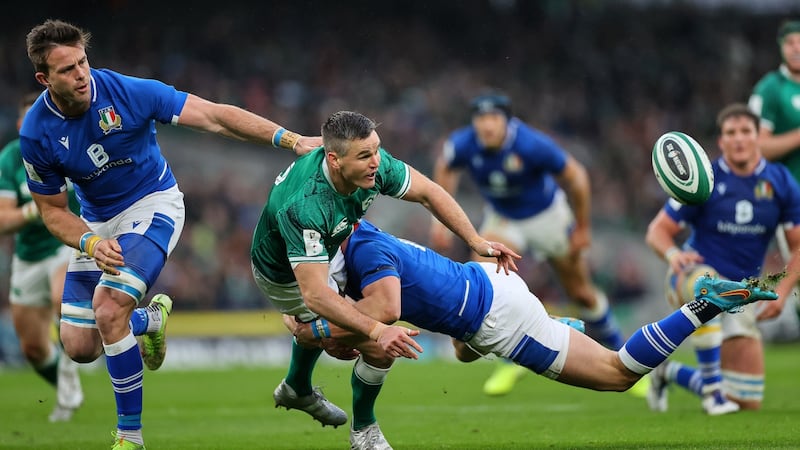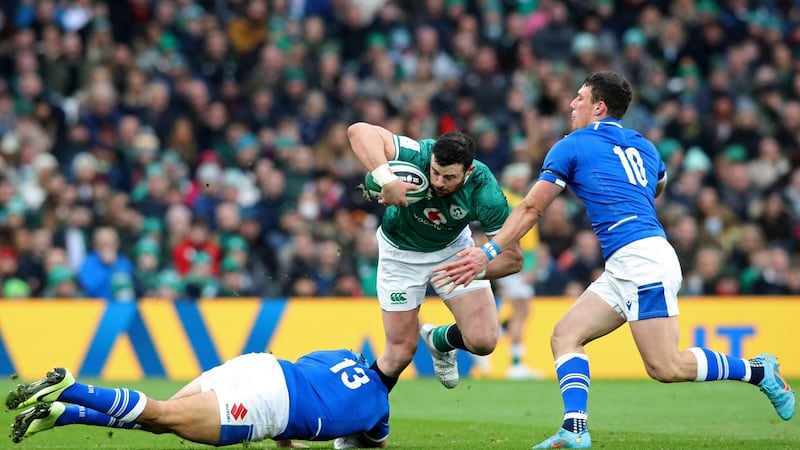Walking down Lansdowne Lane in the aftermath of the Six Nations game at the Aviva stadium, I couldn't shrug off the feeling of acute disappointment when considering what I had just witnessed. Ireland got what they required in the five points but not what they wanted; a match.
The manner in which the Italians were reduced to 13 players, and briefly 12, towards the end of the game will be a topic of debate for some people with their newly acquired wisdom. Whatever perspective you take, no one disputes that the combination of the injury and red card ruined the game as a contest.
In some respects the fiasco temporarily distracted from the more debilitating problem concerning Italian rugby as the team demonstrated character and resilience on the day to mitigate what should have been an even bigger hiding.
Putting the 80 minutes to one side, Sunday was a familiar tale of woe in terms of the outcome, one that has been commonplace for over six years now and counting. Italy last won a match in the Six Nations in the final round of games in the 2015 tournament and Sunday also provided the ignominious milestone, their 100th defeat since five countries became six in 2000.
The fact that supporters love the opportunity to enjoy an extended break in Rome while taking in a Test match is not sufficient reason to ringfence Italy’s participation in the Six Nations. There is a legitimate and growing concern about what, if any, value they are adding to the tournament.
I would suggest that rugby would effectively collapse if Italy was removed from the Six Nations
During the first half of their tenure the Italians were able to win the occasional game but they can no longer live up to that modest ambition. Some of the victories, those pockets of hope in the past, beg the question about whether Italy won or their opponents lost the matches in question?
When you reflect on wins against France or Ireland for example, both those teams were in disarray at the time and it was more a case of Italy capitalising on that rather than implementing a well-executed rugby strategy.
There seems to be a cyclical structural issue within Italian rugby; the incoming president will oversee for the most part the unpicking of his predecessors plans and structures, often prioritising their own agenda ahead of the needs of the playing population. The latest example is getting rid of their under-19 academy last summer that had served Italian rugby so well an underage level over the past five years.
It is a fair question to ask now, is rugby in Italy sustainable or even viable? I would suggest that rugby would effectively collapse if Italy was removed from the Six Nations. If you asked most Italians for their top 10 sports, rugby would not make too many lists. To give you an example, body building is listed at 10th with 550,000 participants and rugby is nowhere to be seen.
In celebrating the French renaissance with French Rugby Federation president Bernard Laporte achieving the impossible, an entente cordiale between national team and the Top 14 clubs, the same accord or harmony of purpose is not there in Italian rugby.

Taking into consideration the standing of the Italian clubs in the United Rugby Championship (URC) and what the national team produces on a regular basis you have to seriously consider if there is any coherent strategic plan for the short-, medium- and long-term development of Italian rugby because it certainly doesn’t look like there is any cogency.
Stephen Aboud, in his six years in Italy – his contract comes to an end in June – created and implemented an elite development player and coaching pathway that heralded unprecedented success for Italian rugby at underage level. But as I have already alluded to, some of those structures are already being picked apart.
Italy boasts a handful of talented players, some very promising young players, a large group of middling ability and then qualified journeymen, all thrown together. The ‘rugby structure’ that underpins the national team is two professional teams in the URC and a 10-club domestic league that was most likely meant to be an outlet for promising young players but it is compromised by self interest.
While Italy is a stakeholder in the Six Nations their presence should not be guaranteed if they cannot be competitive. Removing Italy would most likely move the magnifying glass to Scotland or perhaps Wales and Ireland. This should serve as a warning for Ireland, Wales and Scotland to get their structures in place to genuinely support the international game.
In my opinion Italian rugby has been artificially propped up by Six Nations revenues, it lacks solid foundations in participation and structure terms and is being left behind by its peers both domestically and internationally. They are a good example of the over expansion without the necessary framework in place.
Ireland didn't score as many points as they should – France and <a class="search" href='javascript:window.parent.actionEventData({$contentId:"7.1213540", $action:"view", $target:"work"})' polopoly:contentid="7.1213540" polopoly:searchtag="tag_organisation">England</a> would have piled on more given the same latitude
All those shortcomings manifest themselves in the Test arena. Italy represents the mark in the Six Nations and everyone looks to roll them for five points; anything less and their opponents face an inquisition.
Italy managed to frustrate Ireland, targeting the breakdown for turnovers and allowing players carte blanche to gamble and shoot out of the line in defence. The traditional rules of engagement didn’t apply, something with which Ireland took a long time to come to terms with.
This was a classic example of a game in which Ireland needed to play with their heads up and eyes open in order to adapt the pre-match game plan to the circumstances on the pitch. It took them a long time to cop on and that was partially down to the fact that the result was decided from the 18th minute with the red card.
Ireland didn't score as many points as they should – France and England would have piled on more given the same latitude – but it was the scratchy nature of the performance that will grate; very few of the tries came from slick, well-executed rugby.
Individually Irish players had solid games, led by Peter O'Mahony and supported by Michael Lowry, Caelan Doris, Josh van der Flier and Tadhg Beirne. There is a part of preparing for a match that relies on anticipating what the opposition will do. Ireland's evolution will require more growth in our 'heads-up' philosophy.

There was so much space on the field but save for a few moments orchestrated by Jamison Gibson-Park, Doris and Van der Flier Ireland's approach didn't tally with what was unfolding in front of them. Minds are clouded by the overriding feeling to attack with the ball but all Italy showed was space in behind and we didn't look to expose this till Johnny Sexton arrived.
There was similar frustration for individuals; the amount of half-breaks was incredible, proper breaches denied by some inspirational Italian scrambling and scragging. Robbie Henshaw will consider the game an opportunity missed to push for a starting place against England as the game never fell his way.
There were very few to advance their cause arising from Sunday. That is not to say that Ireland head coach Andy Farrell does not have selections to make, he does have a few but this match will have helped very little with the pecking order in his head. We will no doubt get a good insight with who gets released back to the provinces, in similar fashion to the build-up to this game.
Andrew Porter's ankle issue would have had a few people hold their breath. The only area for discussion in relation to the frontrow is whether Dave Kilcoyne or Cian Healy backs up at loosehead.
While Joey Carbery acquitted himself adequately, at times, his game management did feel a little bit laboured. As I mentioned previously, the primary issue is a lack of experience at Test level and this was amplified by the manner in which Ireland's attack was sharper when Sexton arrived on 53 minutes. There was a tempo change, accuracy increased and so did Ireland's tally on the scoreboard.
Sexton's ability to change the shape of the attack during a match is what sets him apart from his peers
There is no argument as to who is currently the better 10; the thorny issue is trying to get Carbery more game time. The priority is to win games in the tournament and Sexton is the best option to fulfil that remit.
This is not a new issue in Irish rugby and is instead one with which every coach apart from Joe Schmidt has had to deal. The David Humphreys/Ronan O'Gara transition was successfully navigated by the then head coach Eddie O'Sullivan. Declan Kidney tried to oversee the changeover from O'Gara to Sexton but that proved a little more troublesome.
Sexton remains in pole position for the 10 jersey ahead of the England match as Carbery, a little like Henshaw, was unable to really stamp himself on the match. Sexton’s ability to change the shape of the attack during a match is what sets him apart from his peers.
This can come in a variety of different guises and in this instance it was around tempo. While the attack shape has become less reliant on him, I feel that his on-field presence has yet to be adequately filled elsewhere in the squad when he is unavailable.
Sexton’s ability to positively influence whatever team he is playing on comes from experience as much as talent and the squad continue to rely heavily on him for guidance, understandable given his status in the game and current level of performance.
Given the context of the victory over Italy it would be a stretch to say that Ireland have momentum going to Twickenham on Saturday week. What Sunday also reinforced is that Ireland are a better team with Sexton at the helm.








